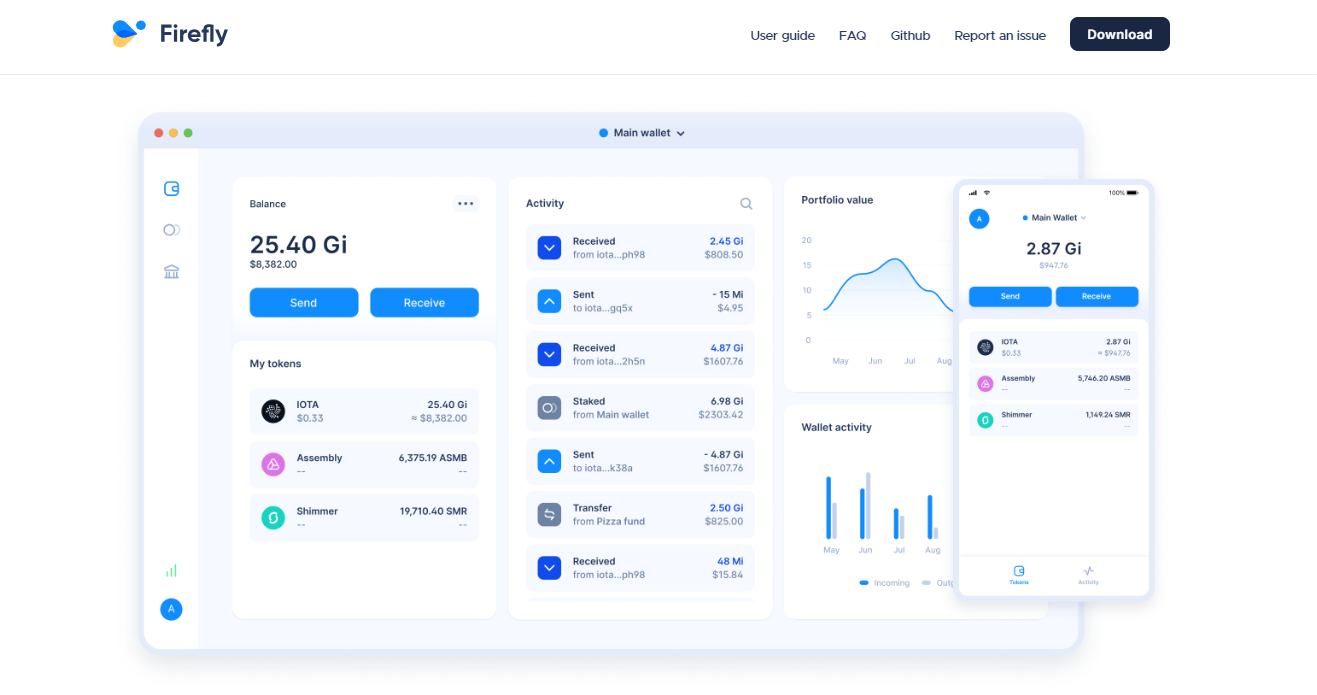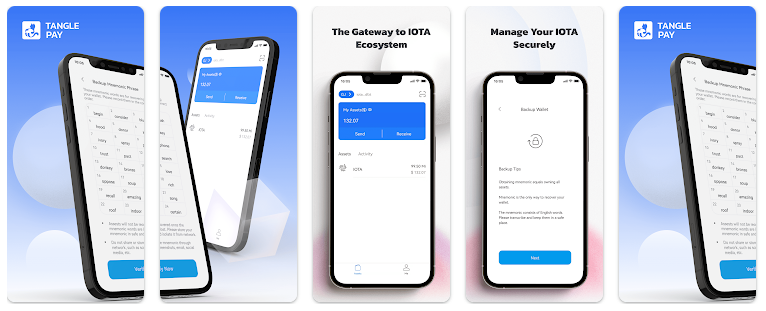IOTA (MIOTA) is a distributed ledger facilitating transactions between machines and physical devices in the Internet of Things (IoT) ecosystem. The IOTA token, MIOTA, is the crypto that helps users settle transactions within the network. Securing and managing your IOTA token in a safe and trustworthy Iota wallet is paramount. But with so many wallets in the market, it can be challenging to determine the best fit for your needs.
Here are the top five IOTA wallets on the market, plus some things to consider when looking for the best IOTA wallet for your portfolio.
Methodology: How did we select the best IOTA wallets?
There are several reputed IOTA wallets around. However, we tested 10+ options over nine months to come up with the best five wallets that tick most boxes for traders/investors. Here are the wallet-specific traits:
Ledger for storing IOTA tokens
Ledger excels in wallet security, boasting features like PIN support and two-factor authentication. For IOTA, Ledger seamlessly connects to the Firefly wallet to access to MIOTA network and track funds. Plus, IOTA tokens on Ledger can be connected to exchanges like Binance, with an option to earn flexible APR or for trading.
Store IOTA on your Firefly wallet
Firefly has evolved into the official IOTA wallet, boasting cornerstone traits like the security-centric “Stronghold” functionality. This feature isolates transactions and keeps the seed phrases away from the attackers. Firefly even integrates seamlessly with crypto exchanges. Over time, this wallet is expected to bring in support for tokenized assets, Dapp interactions, and more.
The user experience is top notch with a PIN-based wallet unlocking functionality. The wallet also aims to serve as a one-stop payment protocol involving IOTA tokens.
Is SafePal good enough for your IOTA holdings?
SafePal is one of the few open-source platforms that makes crypto storage more decentralized in nature. This wallet shines in terms of credibility, with a ten million+ user base. With 100+ chains support, moving IOTA cross ecosystems is possible with SafePal. The security posture is robust, including traits like anti-tamper mechanisms, security audits, and more. User experience is top-notch, courtesy of Bluetooth connectivity.
IOTA tokens on TanglePay
TanglePay has offerings resonating with the IOTA community, including a wallet-specific cross-messaging functionality. Additionally, the wallet supports Dapp interactions and relies on periodic security audits to keep threats out. Finally, the TanglePay mobile app is popular, with over 16,000 active users and 80,000 downloads to date.
Each IOTA wallet brings several novel features to the table. While some offer impeccable security tools, some excel when it comes to web3 access. To know more about BeInCrypto’s methodology verification, click on the link.
What to look for when selecting IOTA wallets?

IOTA’s network of pre-mined coins is managed within a Directed Acyclic Graph called “Tangle.” Transactions in this system are validated by requiring the sender to perform PoW for two transactions. The IOTA’s Tangle system of full nodes confirms transactions with some serious efficiency. According to IOTA, Tangle requires less energy and is faster than traditional blockchain technologies used in other cryptocurrencies.
Selecting the right IOTA wallet can make all the difference in securing and managing your digital assets portfolio. The most critical factor when selecting an IOTA wallet is security.
Ensure that the wallet comprises encrypted private keys, two-factor authentication, and other security features to prevent hacks and theft.
A user-friendly and intuitive UI provides convenience and ease of managing your IOTA wallet. Look for a wallet that offers an easy-to-navigate platform. Whether your device is a desktop computer or a mobile device, ensure compatibility with the wallet. Some wallets deploy web-based versions allowing access to your funds from anywhere, provided you have an internet connection.
As an IOTA user, you want your wallet to have seamless integration with IOTA’s Tangle protocol. Verify that the wallet address you’re considering integrates well with IOTA’s Tangle. Your wallet must have a backup and recovery option in case of lost or damaged physical devices.
What are the best IOTA wallets?
1. Ledger
Ledger is a leading hardware wallet manufacturer with devices supporting 5500+ cryptocurrencies. This non-custodial wallet provider offers offline cold storage for private keys. The Ledger Nano X and Ledger Nano S are sister wallets providing an array of features for both beginners and experienced crypto holders. The key differences between the two leading models lie in the weight, screen resolution, and design of the wallets.
Features
- Large storage
- IoS, Windows, Linux, and Mac support
- 2FA, PIN code, seed phrase
- Mobile app and desktop wallet
- simple navigation
- Multi-currency
- Staking
Pros
- Resourceful content and bots
- Mobile and desktop wallet
- private keys storage offline
- Ledger is versatile
- User-friendly interface and sleek design
Cons
- More expensive than other hardware offerings
- The setup process is time-consuming
- Ledger experienced a significant backlash in May 2023 with the launch of its controversial “Recovery” feature
Don’t wait — get the Ledger wallet today!
2. Firefly Wallet

Firefly replaced the Trinity wallet as the official IOTA wallet. It supports both Ledger Nano S/X hardware wallets. Firefly wallet is a non-custodial wallet with mobile-specific functionality.
Features
- Open-source
- Windows, Mac, Linux.
- Staking and unstaking support
Pros
- Compatible with Ledger hardware wallets
- Mobile and desktop wallet
- Direct trading
- Multiple currency support
- Its user-friendly interface favors beginners
- Resourceful learning content
Cons
- No two-factor authentication or multi-signature support
3. SafePal Wallet
SafePal Wallet offers both a mobile app and a hardware wallet that supports 10000+ cryptos and several digital assets. The non-custodial web3 gateway combines a strong security focus with offering DApp access and NFT support.
Features
- Hardware wallets support
- Staking feature
- Integrates browser extensions, including Brave, Chrome, etc.
- Multiple currency support, including all ERC-20 tokens, BEP2, BEP20, NFTs, TRON, etc
- NFT support
- Multi-signature
Pros
- Two-factor authentication
- Support multiple currencies (10000+)
- Purchases and swaps
- Ease of use
- NFTs integration
- mobile wallet
Cons
- Plastic device
- Limited software wallet integration
Get the safe and reliable SafePal wallet today. Shop now!
4. TanglePay IOTA wallet mobile app

TanglePay IOTA wallet is a mobile wallet with the specific purpose of storing MIOTA. The wallet supports the Chrysalis network and gets updated consistently as per the IOTA Foundation’s roadmap.
Features
- Open-source
- Encrypted private keys
- Very secure and accessible anywhere
- NFT, DeFi support
Pros
- A mobile app
- Convenient and instant trading anytime, anywhere
- Easy to use
Cons
- Only available for iPhone.
The best IOTA wallet depends on your personal circumstances
The best IOTA wallet for you will depend on your expertise, specific requirements, and preferences. The Firefly Wallet is a reliable option tailored specifically for managing MIOTA, while Ledger and Safepal are solid cold wallet choices. Regardless of the wallet you choose, always make sure to follow crypto wallet security best practices.

